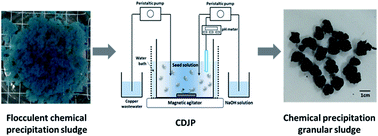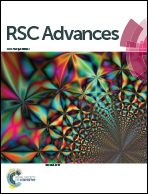Chemical precipitation granular sludge (CPGS) formation for copper removal from wastewater
Abstract
Solid–liquid separation and the settleability of sludge are always issues in copper wastewater treatment by chemical precipitation. To improve the settling performance of chemical precipitation sludge, controlled double-jet precipitation (CDJP) was used to treat wastewater by generating chemical precipitation granular sludge (CPGS). Several parameters such as the pH, copper oxide (CuO) seed dosage, stirring rate, adding rate and polyacrylamide dosage affecting the formation of the CPGS and wastewater treatment were investigated. Results show that the Cu(II) removal efficiency is over 99% and the settling velocity of the CPGS can reach up to 8.1 cm s−1 under optimized conditions, i.e., pH of 11, seed type of common CuO, seed dosage of 2.5 g L−1, stirring rate of 600 rpm, adding rate of 0.5 mL min−1 and PAM dosage of 20 g L−1. This settling velocity was about 18 times higher than that of chemical flocculent sludge. More importantly, the CPGS formation mechanism was explored. A three-step formation mechanism was proposed involving fresh precipitate growth on the seed surface, flocculation, and rearrangement with stirring.


 Please wait while we load your content...
Please wait while we load your content...